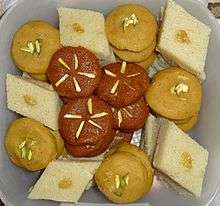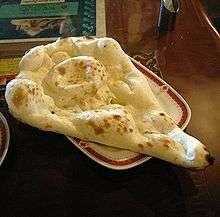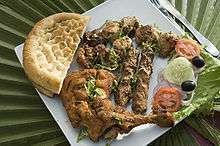Gajar ka halwa
|
| |
| Alternative names | Gajar halva, Punjab gajrela, Punjabi carrot pudding, carrot halwa |
|---|---|
| Course | Dessert |
| Place of origin | India, Pakistan |
| Region or state | Associated with Punjab, India, Haryana, India, Uttar Pradesh, India, Delhi, India and Punjab, Pakistan |
| Serving temperature | Hot or cold |
| Main ingredients | Carrots, milk, water, ghee, sugar |
| Variations | Red velvet halwa, carrot and beetroot halwa, cheesy carrot halwa |
|
| |
Gajar ka halwa (Hindi: गाजर का हलवा, Urdu / Punjabi: گاجر کا حلوە), also known as gajrela,[1][2] is a sweet dessert pudding associated mainly with the North India and Pakistan.[3] It is made by placing grated carrot in a pot containing a specific amount of water, milk and sugar and then cooking while stirring regularly. It is often served with a garnish of almonds and pistachios.[4] The nuts and other items used are first sautéed in ghee, a South Asian clarified butter.[5]
The dessert is favorite all over Northern India and Pakistan. It is traditionally eaten during all of the festivals in India, mainly on the occasion of Diwali, Holi, Eid al-Fitr and Raksha Bandhan.[6] It is served hot during the winter.[7]
Nowadays, gajar ka halwa is a popular worldwide dessert with many variations such as red velvet halwa, carrot and beetroot halwa, and cheesy carrot halwa.
Description
Gajar ka halwa is a combination of nuts, milk, sugar, khoya and ghee with grated carrot. It is a light nutritious dessert with less fat (a minimum of 10.03% and an average of 12.19%) than many other typical South Asian desserts.[8] Gajar halwa has a medium shelf life so it is now sometimes exported.
At festival time many people prefer vegetarian dishes as well as desserts in their Thali. Because of its low fat content, vegetarian characteristics, ease of making, medium shelf-life and taste Gajar ka halwa is a popular dessert all over India and often served at most festivals. The dish is popular among adults as well as children. In 300 grams of gajar halwa there are 268 calories (76 come from fat, 180 from carbohydrate and 16 from protein).[9]
Origins
The gajar ka halwa was first introduced during the Mughal period and the name originates from the Arabic word "halwa", which means "sweet"[10] and it is made from carrot (in Hindi: gajar) so that it is known as gajar ka halwa (meaning pudding of carrot or Halwa of carrot).[11] It is strongly associated with Punjab but it is not clear whether it originated there. It is very similar to the other types of Punjabi halwa. Gajar ka halwa originally contained carrots, milk and ghee but nowadays includes many other ingredients like mava (khoya).[12] This age old traditional recipe remained in Punjabi cookbooks for many years. Being a combination of milk and carrots it is known as milk flavored gajar ka halwa but in the other case, the combination of cream or mava (khoya) and carrot is described as mava flavored gajar ka halwa.[13]
There are many variations of the gajar ka halwa in India, Pakistan and other parts of the world. Although it traditionally includes sugar, its non-sugar variation is also available.[14] Another variation of gajar ka halwa is red velvet halwa in which the main ingredients are carrots as well as rose water.[15]
Recipe and ingredients
There are many variations of gajar ka halwa, but its main ingredients are freshly grated carrots, milk, sugar, khoya, and ghee. The quantity and quality may vary according to personal taste. In the sugar free variant, sugar is excluded from the recipe.[16] For cooking gajar ka halwa, a cooker or kadai is usually preferred. Carrots must first be grated and then dried before cooking. The grated carrots are then put into a heated pan with a specific amount of milk or khoya and sugar. After stirring for 4–5 minutes, roughly chopped cashew nuts are added and 10–15 minutes later a specific amount of pure ghee is added as well. Finally, it is often served with a garnish of almonds and pistachios.[17]
Variations

Gajar ka halwa is a light and popular dessert in most regions of India, Pakistan and appreciated worldwide. Regional/seasonal ingredients are often added to the dish which leads its many variations. These include sugar free gajar ka halwa, carrot-papaya halwa, red velvet carrot halwa, carrot and beetroot halwa, cheese gajar ka halwa, khajur gajar ka halwa and carrot dessert.
The sugar free variation of the traditional gajar ka halwa was developed because due to the large number of diet conscious diabetics in India, Pakistan and world over preferring to avoid/reduce sugar in their diet.[18][19] In this variation of gajar ka halwa, the sugar is removed from the recipe and some more milk is added while the quantity of other contents remains the same. It takes only three-fourths of the time to prepare compared to traditional gajar ka halwa.

In the carrot-papaya halwa, equal amounts of carrot and papaya are used. First, a mixture of carrot and papaya scrapings is prepared. This mixture is fried in a kadai or a cooker with ghee for about 5 minutes. The rest of the process is same as the basic recipe. This recipe has become popular lately because papaya is added to it which provides a different flavor and taste compared to the regular gajar ka halwa.[20] Red velvet carrot halwa is another famous variation of the gajar ka halwa. It is made by heating a comparatively large amount of milk cream along with carrots, sugar, rose water and saffron over low flame.[21] Red velvet carrot halwa is also a vary good source of Vitamin A and Calcium. The gajar ka halwa is prepared traditionally in Indian Kadai. Jaipur, Hyderabad and Mumbai are Indian cities famous for good varieties of gajar ka halwa.
Carrot and beetroot halwa, cheese gajar ka halwa, khajur gajar ka halwa and carrot dessert are the other variations of gajar ka halwa. In public awareness these variations are less popular comparative to traditional gajar ka halwa. All of these variations are differently popular based upon regional/personal preferences. In the carrot and beetroot halwa, specific amounts of grated beetroot is added to grated carrots and this mixture is heated in a kadai on a low flame and further a specific amount of mava and sugar per choice is added to it. After 30 minutes of stirring and cooking, carrot and beetroot halwa is ready to be served. Cheese gajar ka halwa is prepared with a combination of purple carrots and ricotta. This dish is popular in northern India because purple carrots are mostly grown there.[22]
See also
References
- ↑ Julie Sahni (1985). Classic Punjabi vegetarian and Grain Cooking. HarperCollins. p. 512. ISBN 0-688-04995-8.
- ↑ "Gajar Ka Gajrela". NDTV Cooks. Retrieved 23 August 2012.
- ↑ "Vasundhara Chauhan Article72932". Chennai, India: The Hindu. 2 January 2010. Retrieved 23 August 2012.
- ↑ "Carrot Halwa Panna Cotta". Gulfnews. Retrieved 23 August 2012.
- ↑ Leverkuhn, A. "What is Carrot Halwa". Retrieved 23 August 2012.
- ↑ - Nanakfoods "Gajar Halwa on Festivals"
- ↑ "Recipe Khajur Gajar Halwa Carrot and Date Pudding with Coconut and Cardamom on Winter". Onegreenplanet.org. Retrieved 23 August 2012.
- ↑ Dr. Kumudini R. Dhore. "Evaluation of Fat Content in Gajar Halwa" (PDF). Retrieved 24 August 2012.
- ↑ "Nutrition Facts". Quitehealthy.
- ↑ Sharma, Vaishali. "Gajar ka Halwa (Sweet Carrot Pudding)". Retrieved 29 August 2012.
- ↑ Rosen, Diana. "Carrot Halwa". Retrieved 29 August 2012.
- ↑ Penny Isaacs; Sarah Lockett (2009-02-14). The Dish. Troubador Publishing Ltd. p. 139. ISBN 9781848761018. Retrieved 5 January 2014.
- ↑ The Raman family (2012). "Carrot halwa Veg". bbc.co.uk. Retrieved 29 August 2012.
- ↑ Kapoor, Sanjeev. "Gajar Halwa Sugarfree". chefsanjeevkapoor. Retrieved 29 August 2012.
- ↑ Mangla, Sonia. "Red Velvet Halwa with Carrots and Rose water". Retrieved 29 August 2012.
- ↑ univc. "Sugar free Gajar Halwa". Retrieved 1 September 2012.
- ↑ Procopio, Michael. "Carrot Pudding". kqed.org. Retrieved 29 August 2012.
- ↑ "Over 50 million diabetes cases in India". The Hindu. Chennai, India. 21 October 2009. Retrieved 28 September 2012.
- ↑ Nordqvist, Christian (11 January 2006). "Diabetes Cases Rise From 30 Million To 230 Million In 20 Years". Medical News Today. Retrieved 28 September 2012.
- ↑ "Carrot Papaya Halwa". Retrieved 28 September 2012.
- ↑ Gupta, Sonia. "Red velvet gajar halwa". Retrieved 28 September 2012.
- ↑ Sahni, Chetna. "A Mad Tea Party". Retrieved 28 September 2012.



